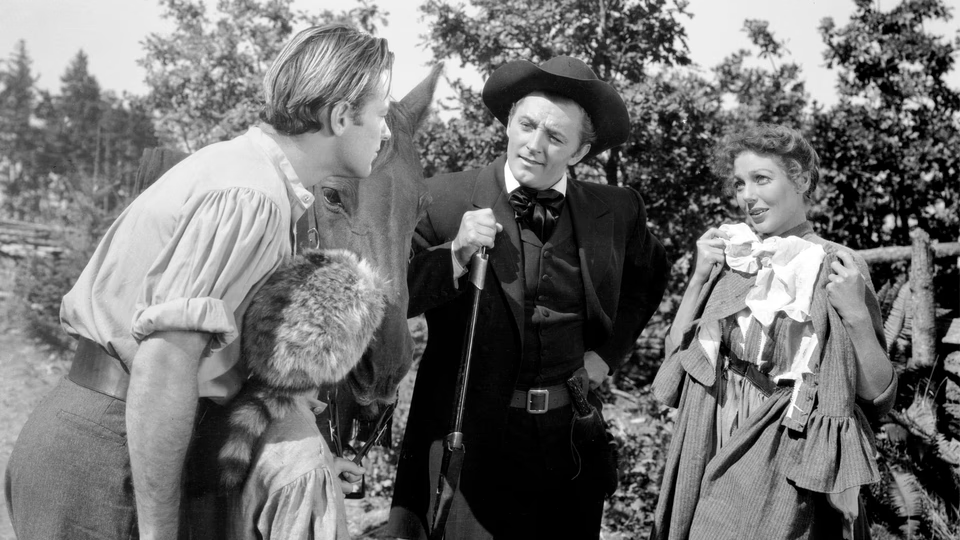Rachel and the Stranger

William Holden plays David Harvey, a farmer living with his young son Davey in the frontier wilderness. David’s wife Susan died a year ago, sinking him into depression. After discovering Davey using his school books as fodder for toy boats, David resolves to take a new wife. Not for love, but because Susan was adamant that Davey not grow up “woodsy”.
David travels to the nearby stockade—an impressive set—and consults the Parson. The Parson suggests David buy the contract of a bond woman named Rachel, played by Loretta Young. David likes the idea. A woman, but not a wife.
But the Parson says, “Decent church folk don’t live together, man and woman, under the same roof without marriage.” So David marries Rachel and takes her back to his farm.
David proves distant, allowing Rachel the bed while he sleeps on the floor in another room. Rachel works to endear herself, but David takes no notice.
Davey, however, proves downright cruel. When Rachel tells him his father brought her there to school and mother him, Davey spits back, “The devil it was! You’re a bond slave, is all!”
Things change when Jim, a family friend played by Robert Mitchum, arrives. He was a one time suitor of Susan, and it surprised both him and David when she chose David over him. Jim plans to settle down and takes an instant interest in Rachel.
Jim showers attention on Rachel. David gets jealous. Competition flares, culminating in a fist-fight that leads to Rachel storming out to return to the stockade. The men pursue but a plot-convenient Indian attack interrupts the melodrama.
Young and Holden convince as pioneers, and Mitchum shines as a laconic woodsman. But this is not a good movie. It treats us like simpletons.
Consider when, after arriving in the cabin, Rachel is clearing the table. David and Davey are talking. Davey says he won’t be getting any music lessons. Rachel pauses. Cut to a drawn-out close-up of Rachel. She gazes off screen, opens her mouth, then closes it and looks down at Davey. Davey glares back, daring her to talk. She doesn’t and walks away. It’s a ten second scene that should have played out in an instant, but the film thinks us incapable of grasping subtlety.
The script proves clumsy too. Consider the scene where David and Davey are out chopping wood. They hear a turkey call. Davey whines about wanting to take a shot at the bird. David grabs Davey and dives to the ground. The turkey call is a Shawnee signal, he says. Of course, it’s just Jim, but when he steps out of the trees to greet David, he recounts signs of Shawnee up north. The script hasn’t mentioned native Americans up to this point. Now, it mentions Shawnee four times in two minutes, only to forget them again until the finale. This scene, like the Indian attack itself, feels forced. The Shawnee exist as a convenient plot device to reunite David and Jim.
Much of the film works this way. Rachel acts as a timid, reserved mouse until Jim and David get into a fight, then she storms out. Rachel must leave so that David can win her back. Davey spends most of the film spitting venom at Rachel, but after she cooks him a meal one night, he’s happy to have her as his mother. Davey must like her so David can fall in love.
And speaking of Davey, he’s whiny and obstinate. We’re given no reason to like him. Yes, he misses his mother. But the way he’s portrayed, one suspects he was annoying long before Susan departed this earth.
Such a disappointment. The three leads ooze talent, and the production values shine. But the reductive script proffers a hackneyed melodramatic fable masquerading as adult drama. We deserve better.